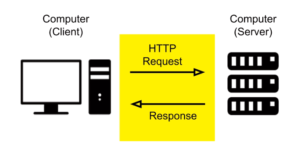Why is it essential, and what are the ways to make the HTTP requests in Nodejs? Let’s get clear it up with the below blog.
Here we go . . .
HTTP requests are the process of fetching data from a remote source. It may be a website or an API. In simple, when you require some code to get valuable data from any remote sources. These HTTP requests emerge as the core part of modern languages.
Build an Ecommerce Platform with Webnexs headless solution!!!
The server then processes this Request, and another set or pack of information is sent back to the client. This packet(collection of information) contains all the necessary data requested by the client and is known as the response.
In our previous blog, we discussed creating a Nodejs web server to handle HTTP requests.
This blog gives you the solution: several ways to make Nodejs HTTP requests from your Node apps.
You may ask us why we should want to make HTTP requests in between. Following the question, the two applications came into play – web scraping and proxying.
Scrapers – software that downloads web pages and extracts data and other related formations from them.
Proxy – a server act as median or an intermediary that makes forwarding client requests to other servers and returns the responses.
An HTTP request is made up of the following elements:
- Request Line
- Headers
- Body of the Request
An HTTP client sends a request to a server in the form of a message in the following format:
- A Request-line
- Zero or more header
- An empty line
- Optionally a message-body
Before proceeding to the next step, ensure that you have installed the latest version of Nodejs and NPM.
Preferred five ways to make Nodejs HTTP requests in 2022

REQUEST – HTTP requests
A request is a clarified HTTP client that is much more user-friendly. When compared to the default HTTP module, developers find Request more effective. It is trendy among developers and is considered a go-to HTTP client for Nodejs projects.
Unlike the HTTP module, this demands you to install this as a dependency from module resources called Node Package Manager (npm) using the following command:
$ npm install request --save
Following is an example code snippet that utilizes the Request HTTP client to call a duplicate REST API:
const request = require('request'); request('https://jsonplaceholder.typicode.com/todos/1', { json: true }, (err, res, body) => { if (err) { return console.log(err); } console.log(body.id); console.log(body.title); });
GOT
Got is another user-friendly like Request. A lightweight HTTP requests library for Nodejs. To install, Got from the Node package manager with the following command:
$ npm install got --save
Just like Axios and Needle, Got will also support Promises. The following code snippet will call duplicate REST API to get todo information:
const got = require('got'); got('https://jsonplaceholder.typicode.com/todos/1', { json: true }) .then(res => { console.log(res.body.id); console.log(res.body.title); }).catch(err => { console.log(err.response.body); });
NEEDLE for Nodejs HTTP
A good streamable HTTP client for Nodejs supports proxy, iconv, cookie, deflate, and multi-part requests. To install Needle client from Node package manager, initiate the following command in your terminal:
$ npm install needle --save
The following code snippet will do the same task of calling duplicate REST API and printing the details:
const needle = require('needle'); needle.get('https://jsonplaceholder.typicode.com/todos/1', {json: true}, (err, res) => { if (err) { return console.log(err); } let todo = res.body; console.log(todo.id); console.log(todo.title); });
AXIOS – HTTP client
Axios is a Promise-based HTTP client for the Nodejs. Unlike the other HTTP clients such as Request and Needle, Axios automatically converts the response data into a JSON object. It is a simple yet a neat way to make Nodejs HTTP requests in Nodejs. Run the following command in your terminal from the root directory:
$ npm install axios --save
Since it supports Promises, it reduces the need to code to call duplicate REST API as above for HTTP client:
const axios = require('axios'); axios.get('https://jsonplaceholder.typicode.com/todos/1') .then(res => { console.log(res.data.id); console.log(res.data.title); }) .catch(err => { console.log(err); });
Another benefit of Axios, it supports multiple concurrent requests with axios. all. With a simple illustration, we can concurrently call duplicate REST API to get two todos information at once:
const axios = require('axios'); axios.all([ axios.get('https://jsonplaceholder.typicode.com/todos/1'), axios.get('https://jsonplaceholder.typicode.com/todos/2') ]).then(axios.spread((res1, res2) => { console.log(res1.data.title); console.log(res2.data.title); })).catch(err => { console.log(err); });
THE r2 MODULE
The r2 module comes first to use Promises. It is an implementation of the browser’s Fetch API client in Nodejs. It primarily uses the same API as window.fetch with fewer dependencies, which means r2 depends on node-fetch.
Run the following command in a terminal to execute:
npm i r2
Same as before, the following code snippet will call a duplicate REST API to get todo information:
const r2 = require("r2"); const url = "https://jsonplaceholder.typicode.com/posts/1"; const getData = async url => { try { const response = await r2(url).json; console.log(response); } catch (error) { console.log(error); } }; getData(url);
Conclusion
Still, Nodejs has various other methods to make HTTP requests that we didn’t list here. With this, Nodejs proves its potential in the technical aspects of web application development.
If you’re planning to build a Nodejs web application, Contact us for cost-effective development services.

Leave a Reply